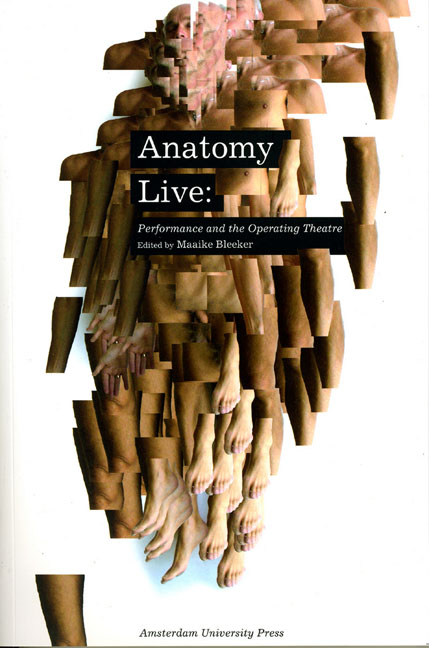Book contents
- Frontmatter
- Contents
- Acknowledgements
- Prologue - Men with Glass Bodies
- Introduction
- Performance Documentation 1: Holoman; Digital Cadaver
- Digital Cadavers and Virtual Dissection
- ‘Who Were You?’: The Visible and the Visceral
- Performance Documentation 2: Excavations: Fresh but Rotten
- The Anatomy Lesson of Professor Moxham
- ‘Be not Faithless But Believing’: Illusion and Doubt in the Anatomy Theatre
- Performance Documentation 3: De Anatomische Les
- Of Dissection and Technologies of Culture in Actor Training Programs – an Example from 1960s West Germany
- Ocular Anatomy, Chiasm, and Theatre Architecture as a Material Phenomenology in Early Modern Europe
- Performance Documentation 4: Camillo – Memo 4.0: The Cabinet of Memories – A Tear Donnor Session
- Martin, Massumi, and the Matrix
- Performance Documentation 5: Sensing Presence no 1: Performing a Hyperlink System
- ‘Where Are You Now?’: Locating the Body in Contemporary Performance
- Performance Documentation 6: Under My Skin
- Anatomies of Live Art
- Performance Documentation 7: Crash
- Restaging the Monstrous
- Delirium of the Flesh: ‘All the Dead Voices’ in the Space of the Now
- Performance Documentation 8: Körper
- Operating Theatres: Body-bits and a Post-apartheid Aesthetics
- Index
Delirium of the Flesh: ‘All the Dead Voices’ in the Space of the Now
Published online by Cambridge University Press: 10 February 2021
- Frontmatter
- Contents
- Acknowledgements
- Prologue - Men with Glass Bodies
- Introduction
- Performance Documentation 1: Holoman; Digital Cadaver
- Digital Cadavers and Virtual Dissection
- ‘Who Were You?’: The Visible and the Visceral
- Performance Documentation 2: Excavations: Fresh but Rotten
- The Anatomy Lesson of Professor Moxham
- ‘Be not Faithless But Believing’: Illusion and Doubt in the Anatomy Theatre
- Performance Documentation 3: De Anatomische Les
- Of Dissection and Technologies of Culture in Actor Training Programs – an Example from 1960s West Germany
- Ocular Anatomy, Chiasm, and Theatre Architecture as a Material Phenomenology in Early Modern Europe
- Performance Documentation 4: Camillo – Memo 4.0: The Cabinet of Memories – A Tear Donnor Session
- Martin, Massumi, and the Matrix
- Performance Documentation 5: Sensing Presence no 1: Performing a Hyperlink System
- ‘Where Are You Now?’: Locating the Body in Contemporary Performance
- Performance Documentation 6: Under My Skin
- Anatomies of Live Art
- Performance Documentation 7: Crash
- Restaging the Monstrous
- Delirium of the Flesh: ‘All the Dead Voices’ in the Space of the Now
- Performance Documentation 8: Körper
- Operating Theatres: Body-bits and a Post-apartheid Aesthetics
- Index
Summary
Estragon: All the dead voices.
Vladimir: They make a noise like wings.
Estragon: Like leaves.
Vladimir: Like sand.
Estragon: Like leaves.
(Silence)
Vladimir: They all speak at once.
Estragon: Each one to itself.
(Silence)
Vladimir: Rather they whisper.
Estragon: They rustle.
Vladimir: They murmur.
Estragon: They rustle.
(Silence)
Vladimir: What do they say?
Estragon: They talk about their lives.
Vladimir: To have lived is not enough for them.
Estragon: They have to talk about it.
Vladimir: To be dead is not enough for them.
Estragon: It is not sufficient.
(Silence)
Vladimir: They make a noise like feathers.
Estragon: Like leaves.
Vladimir: Like ashes.
Estragon: Like leaves.
(Beckett, Waiting for Godot, 1954, p. 40)
In the celebrated The Body Emblazoned (1995), Jonathan Sawday places the dead body at the centre of enquiry into the Renaissance culture of dissection. The abstract idea of theological knowledge about the body (Hoc est corpus meum), which had been given visibility by the dogma of transubstantiation in 1215, was now under a knife, which cut through a corpse. That which was revealed was assigned a non-theological status as well as a rational, not to say empirical, function. From now on, it will be possible to arrange and rearrange the elements constituting the bodily knowledge, displayed both as a corpse and as a nomos on a dissecting table.
Sawday 's argument, however, not only draws attention to how what was seen on the table of the Renaissance culture of dissection was constructed rationally and discursively, but also, how the Renaissance culture of dissection divided the bodies (or their parts) into those that mattered or did not matter. At the same time, Sawday's The Body Emblazoned marks a shift in the field of Renaissance studies from logocentric towards corporeal investigations. A multitude of volumes and conferences that followed and whose subject-matter is bodies tremulous, bodies single-sexed, bodies enclosed, bodies intestinal, bodies consumed, bodies carnivalized, bodies effeminized, bodies embarrassed, bodies sodomized, bodies castrated, or approximate bodies is an example par excellence of this shift.
- Type
- Chapter
- Information
- Anatomy LivePerformance and the Operating Theatre, pp. 223 - 244Publisher: Amsterdam University PressPrint publication year: 2008



